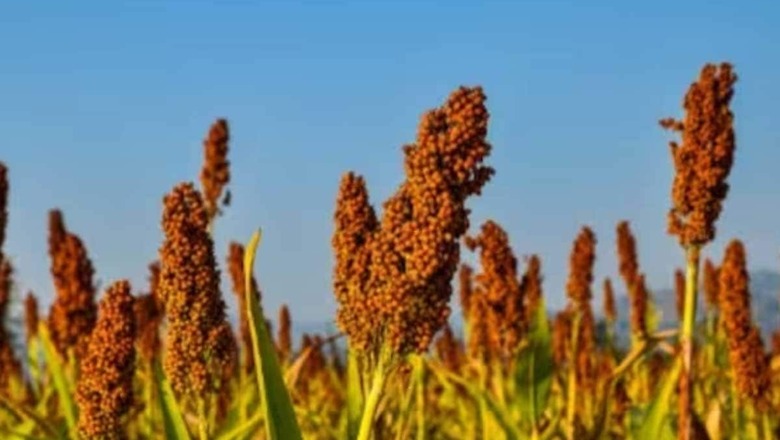
views
Millet, millet, everywhere – this paraphrasing of a Coleridge poem is only a slight exaggeration in India, a country which is one of the largest producers and exporters of the grain in the world. Millets are present in cuisines across the country, be it Punjab’s bajre di roti, mudde or hittu in Karnataka and Andhra Pradesh, ragi kali in Tamil Nadu, or jowar bhakri in Maharashtra.
As health and wellness become paramount for Indians and sustainability becomes their guiding light, millets are increasingly emerging as a unique culinary alchemy that blend nutrition, tradition, and innovation into a single grain.
Millets in India: Why the popular grain has become a superfood
“The history of millet in India reaches back to the dawn of civilisation on the subcontinent but, for the longest time, the grain was a victim of its own success. Being so widely available and affordable, it was relegated to the status of a meal for the masses, a mota anaaj (thick grain) which is not very suitable for consumption and was often replaced in diets by grains perceived to be ‘richer’, such as rice and wheat, whenever possible,” says Shilpa Vora, Chief R&D Officer, Marico Limited.
Millets just weren’t fashionable enough.
In recent years, the grain category has registered a refreshing change of perception. Its value as a rich source of protein, fibre, micronutrients, essential amino acids, and phytochemicals is catching public attention. “The health benefits of a millet-based diet extend to blood sugar regulation, satiety, and improved heart health. Combined with being high in antioxidants, these factors are leading to a drastic re-evaluation of millets’ status and driving its awareness as a superfood,” adds Vora.
But that’s not all. Millets are also far more sustainable crops to grow, consuming about 50% less water than wheat and almost three-quarters (70%) less water than rice for cultivation. Vora states, “At a time when extended droughts and low rainfall might become more common, especially with large-scale climate events such as El Nino dominating weather patterns, a shift to millets as the main item of the plate is anticipated in near future. It has a low carbon footprint. Millets are sturdy crops that can grow in arid regions with water shortage. It benefits the farmers as crop rotation with millets significantly improves the quality of soil. Thereby, millets precisely fit the bill for the sustainable food systems delivering food and nutrition security agenda, which is a major component of SDG (Sustainable Developmental Goals) 2030 of the United Nations (UN).”
Increasing popularity: The efforts that have established millets on a wider scale
The growing popularity of millets has been bolstered by culinary innovations which have integrated millets into the symphony of flavours of India’s regional delicacies. Hyderabadi biryanis now come in variants where millets combine with aromatic spices, while tangy ragi dosas boasting a blend of nutrition and taste have been gracing our plates – and our palates – for some time.
“Millet’s transformation beyond its traditional grain form has also helped to accelerate adoption. Top brands in the FMCG and CPG space have turned the grain into a wide range of products, from ready-to-eat snacks such as murukku, muesli, cookies, and granola to easy-to-cook meal products such as khichdi, upma, bread, noodles, pasta, salads, and poha. For instance, Marico Limited has recently launched healthy snacks such as Saffola Munchiez Ragi Chips and Saffola Oats Gold that combines goodness of Jowar with oats. Many bakeries, hotel chains, and restaurants are also using millets in their recipies to create delectable dishes and desserts, with chefs such as Raveena Taurani and Karam Dogra reimagining popular recipes with the grain and sharing their preparations on social media to generate mass interest and curiosity,” opines Vora.
The Indian government has also stepped up its efforts to popularise millets, both as a superfood and a super crop, with an increased focus on millet production, consumption, and export. The Minimum Support Price (MSP) for millets has been raised to incentivise more farmers to grow the grain, while the Department of Agriculture and Farmers Welfare (DA&FW) is implementing a sub-mission on Nutri-Cereals (Millets) under the National Food Security Mission (NFSM). Key stakeholders, including the Prime Minister, Mr. Narendra Modi, have propelled the agenda on popularising millets at domestic and international platforms. This eventually has led to the UN’s Food and Agriculture Organization (FAO) declaring 2023 as the International Year of Millets. Recently, they were proudly declared as “Shri-Anna” by the PM. Turning millets into an integral part of the diet is expected to help the government address multiple concerns, such as tackling food and nutrition insecurity, growing food exports, and fostering more water-sustainable agricultural practices. Indian dietary guidelines also recommend consuming 20-30% of grains as millets which will help fulfil the required intakes of whole grains, and fibre in a balanced diet.
The Millet Movement is far more than just a culinary adventure; it’s a sustainable journey towards awareness, and transformation of hearts and minds. From bustling city streets to rural households, food enthusiasts, celebrity chefs, FMCG brands, and home cooks all are taking part in telling a captivating story of millets’ virtues and delicious escapades. The stage is set for a flavourful revolution to forever change the way we savour Indian cuisine – while nourishing our bodies, supporting our farmers, and protecting our planet.
Let the adventure begin!

















Comments
0 comment